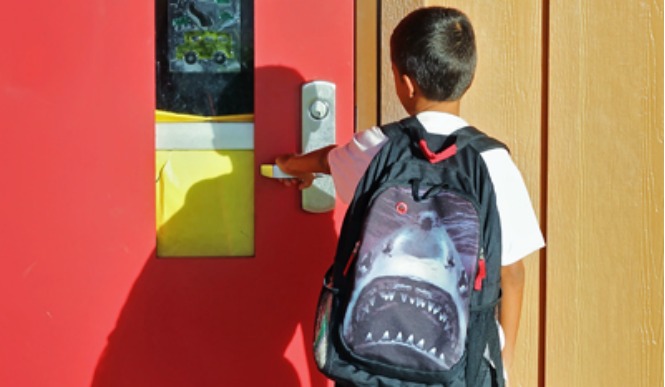They’re all the rage and if your kid doesn’t have one by now, they’ve at least begged for one.
Fidget spinners have caused a colossal tidal wave among children worldwide. Catherine Hettinger, the inventor of the globe’s most sought-after toy actually created the gadget 20 years ago. Why it’s spreading like wild fire now can only be explained by the same phenomenon that made Furbies and Beanie Babies so popular. Who knows why, but kids love ‘em and they bring their fidget spinners to school every day.
This is causing quite the disruption in classrooms, as you can imagine. What was meant as a therapy tool for the anxious, now fidget spinners are whipping and zooming during reading lessons and math exercises. Some classrooms have outlawed them already.
But that leads to the question of are these spinning toys distraction or therapy?
Distraction or Therapy?
By design, fidget spinners rely on equal weight distribution of ball bearings rotating around a central axis. They’re actually pretty cool. When my six-year-old son first bought one with his own chore money, I thought, “Well that’s stupid.” And then I spun it between my finger and my thumb…and spun it again and again. In a matter of seconds, I was hooked.
And it’s no wonder, fidget spinners are handy little aides for children and individuals suffering from all types of disorders. Fidget spinners are used in therapy to help those with autism, anxiety, and ADHD. The momentum of the toy provides sensory feedback and stimulation that is soothing to kids with developmental challenges.
In the classroom, a fidget spinner can help a hyperactive child focus. It can curb an anxiety attack and provide helpful stimulation for kids with autism. The problem is, everyone is bringing a fidget spinner to class, not just the children who need them. This causes lots of distractions and a heap of unhappy educators.
To Ban or Not to Ban
So should all fidget spinners be banned from schools? No one wants their child’s education being disrupted or worse, thwarted. It is annoying to think that your child can’t concentrate on his long division because the kid next to him is spinning a toy uncontrollably.
But what about the kids who really need them? If there’s a way to weed out the ones who don’t need them from the ones who truly could benefit from having a fidget spinner handy, great. As a mom of four, I can foresee many That’s not fairs! And as a former teacher, I know what a frustrating pill that is to swallow.
Bottom line: if you think your child could sincerely benefit from a fidget spinner, advocate for her. But if it’s about entertainment, save the fidget spinner for recess, or better yet—leave it home.
Fidget spinners are what long car rides and lengthy doctor’s visits were made for, I say.
Sources: “Fidget Spinners: What They Are, How They Work and Why the Controversy.” Live Science. 19 May 2017.
Brunstein, Joshua. “How the fidget spinner origin story spun out of control.” Chicago Tribune. 15 May 2017.
Fidget spinner photo credit: Amazon






Johny says
I think they should be banned during the class, but they can use it in the breaks. I guess it really helps to focus, but you should focus on learning and not playing in the classroom.
White says
There is a difference between playing with it and using it as a tool. People with anxiety, ADD/ADHD, autism, etc. use it as a tool and a means to keep their hands occupied. As a person with ADD and anxiety, I can say it is very hard to focus on learning without anything there to help me with my fidgeting.
Kyle Ehlis says
4th grade teacher here…school banned them from recess time. I did not ban them from the classroom and had a ten minute discussion with the class. In the last month and a half, I took one spinner away and kept it for a week. We take them out the last few minutes on Friday and spin. With it not being huge deal in the room, kids are not playing with them all day. A little management and “non-freakout” attitude to a minor problem can go a long way.
Elsie says
My 11 year old daughter has a light up one and the only reason she has one is because she has ADHD my 14 year old daughter has one also because she has eplspey sesiers and she needs it both of them do 😶😶😶😶😶
sheepdog says
I’m sorry
tarrin says
okay
Tammy McCullars says
I think it should be left up for the teacher to decide if it is helpful or a distraction and not go full ban. Some kids cannot sit in their seats without constantly moving around, jumping up, etc. If this helps the child concentrate better, then go for it. I got a couple for my jumpy grandson. It has helped him tremendously. But like every other teaching tool, there is a time and a place for everything. Let’s face it, we live in a world of multitasking and I don’t see it ending with this generation. If they can play with the fidget and get their math or reading done, then that is a plus.
jennifer theuriet says
My daughter has ADHD and an IEP
but I do think there are more appropriate tools to keep her focused in the classroom.
Elsie says
Did you read about the child that swallowed on of the barrings. She was cleaning it (?) in her mouth. Emergency room visit to remove it.
Diane Fritz says
I have a child with autism. This is a typical soothing mechanism for some children (particularly those with special needs). They should not be banned.
Lori Taniguchi says
Some kids have learned how to take them apart and throw the ball bearings at other students.
Melinda Johnson says
Yes, ban them! I have to ban them in my home school as well. I did buy one BEFORE the craze hit to see if it would help my kids sit still during read aloud time. Well, it didn’t help terribly much for my kids who do NOT have any learning or physical disabilities. I agree, unless it’s written in an IEP or a child has a doctor’s note that he/she has a diagnosis like ADHD, Austism, ADD, etc., the spinners should be left at home. Kids will fidget with whatever is handy though, because they are used to their fingers being occupied by their electronic gadgets. My husband refuses to buy pens with click tops because at 38 years old, he still will keep clicking them. Anyway, it’s a tool, not a toy.
Cristy says
There are hundreds of different types of fidgets – balls, spinners, clickers, fidgets you blow into, putty to knead, some are loud, others are quiet, some and the list goes on. The trick is to fine a fidget that works for a particular child because each type of fidget provides a different type of sensory input.
Our special needs kiddos are taught that any fidget is a TOOL – until it becomes a TOY. If you are PLAYING with it, it is a toy and needs to be put away. If you are using it to help focus on your work, it is a tool and should be allowed.
I would be hesitant to start banning particular fidgets in the classroom. My son has autism and can go most of the day without a fidget. One of his friends, however, needs a fidget to keep from pulling his hair out one strand at a time. If he has a (quiet!) fidget that works for him, then it needs to be allowed.
That said – even a fidget can be inappropriate if it distracts other people. For instance, if a spinner makes noise, then either it should be used farther away from other students or every effort should be made to find an alternative fidget that provides the same input. If one cannot be found, the Special Education team should work with the student in the classroom to find a way to use it that will not distract others. If it is quiet, and it is a distraction because other kids think it is cool, then it is still appropriate – for those that use it as a TOOL. It can always be used as a toy outside the classroom by those that don’t need it.
Shaylee says
Agree with you completely!!
Katherine Johnson says
I don’t think they should be banned, It does help my child that has ADHD and Autism. He is able to focus more and pay attention. Even his Teacher said she had noticed a difference in his focus and attention.
K says
Our school has banned fidget spinners unless it is written into an IEP or 504 plan. They have been causing a huge disruption in the classroom. I see that they help some students focus and I am glad that we can allow them for students who need them.
Jada Roberts says
I say ban them for the sole reason that I’ve had 3-5 spinners stolen tfrom kids just this week while subbing in 1 classroom.
Sina says
Yes, i think that they should banned from classrooms. Some of these toys are really loud and i don´t think, that in that case they could help to focus.
Mark Cespedes says
Fidget spinets help focus
White says
From the sounds of thing, you are not an individual suffering from ADD/ADHD, autism, anxiety, etc. Therefore, I do not think it is fair for you to be saying “I don’t think that in that case they could help to focus.” I have ADD and anxiety myself, and yes, they DO help focus. When I have a spinner in my hand, I can get much more work done than if I didn’t. So, no, they should not be banned completely. Only for people who don’t have issues.